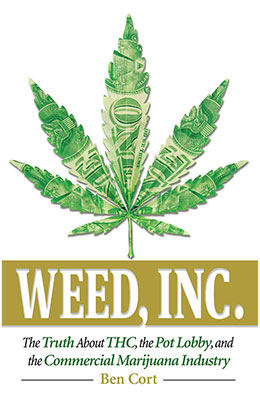
VERDICT: Touchdown!
Weed, Inc.: The Truth About THC, the Pot Lobby, and the Commercial Marijuana Industry
By Ben Cort (Deerfield Beach, FL: Health Communications Inc., 2017). 250 pgs. $15.95. Order, www.amazon.com.
Reviewed by Thomas J. McClure
Societal changes create new laws, with which lawyers must become conversant. The desire for legalization of marijuana for recreational and medicinal use has spurred recent debate nationwide. Weed, Inc.: The Truth About THC, the Pot Lobby, and the Commercial Marijuana Industry has a wealth of historical and scientific information about legalizing marijuana. It stresses the importance of additional national conversation, and particularly, scientific and medical studies, of marijuana, as a result of Colorado’s constitutional amendment legalizing marijuana use in 2012, known as AG 64. That state’s recent five-year experience in legalization of recreational pot use forms the raw data of the book. No matter the practice area or interests, this is a valuable and timely book every lawyer would benefit from.
Want to Review a Book?
Please request a book and writing guidelines from Wisconsin Lawyer managing editor Karlé Lester, at klester@wisbar.org or (608) 250-6127. Reviewers may keep the book reviewed. Reviews of about 500 words are due within 45 days of receiving the book. Reviews are published, space permitting, in the order received and may be edited for length and clarity.
The author wrote this book as an “overview and a conversation starter” (p. 12). Regardless of the reader’s view on decriminalization of marijuana use, this book provides a thorough education on the topic. Ben Cort, a former drug addict and recovered alcoholic in his 30s, is associated with the University of Colorado substance abuse treatment program.
Cort’s passion for addiction prevention and treatment is evident in the impassioned manner in which he demonstrates that marijuana sold today is no longer the low-grade level of Woodstock nostalgia. Most readers are probably unaware that “cannabis withdrawal” has now been added, for the first time, as a category of “substance abuse disorder” in the latest edition of the American Psychiatric Association’s (2013) Diagnostic and Statistical Manual of Mental Disorders (DSM-5). Marijuana can be addictive and lead to dangerous psychosis.
Cort, personally, is not an opponent of recreational use of weed. But he has seen it quickly becoming a hazard in Colorado, primarily due to commercialization and the development of myriad products, in almost unlimited forms, to encourage increasing purchases and consumption, by people of all ages.
The two most significant chemicals naturally occurring in the cannabis plant are THC and CBD. THC causes the physiological response in the brain known as “getting high.” CBD, in contrast, has been found to relieve some pain or neurological symptoms in persons with certain medical afflictions; it is therefore the basis for the initiative of “legalizing marijuana for medicinal purposes.”
Cort points out neither THC nor CBD is inherently valuable for a person’s health. In the unenhanced natural cannabis plant, THC and CBD are only at about a 1 percent level (and essentially neutralize each other). It is only with special breeding of the plant today that THC levels are enhanced up to 10, 20, or 40 percent, so sellers can advertise a “better, faster high.” CBD, although anecdotally promising for medicinal symptom relief, has yet to be found to cure any disease. And with the ramp up of THC “concentrated” products, with ever-increasing THC levels for weed smoking, vaping inhalation, and “edibles” eating, Cort argues society needs to take a big second look at Colorado’s five-year marijuana experiment.
As the title indicates, the book is an exposé of the dark side of what happened with Colorado AG 64, namely the explosive commercialization of legalized marijuana and the outrageous drive to enhance its potency and increase its consumption. Because marijuana is still illegal in most states, there is no federal ability to regulate it; therefore, Colorado is the perfect incubator to judge how the AG 64 law panned out. Cort argues that it has not, and that the rest of the states should take action accordingly.
Thomas J. McClure, Marquette 1980, is a solo general practice trial attorney in Delafield.
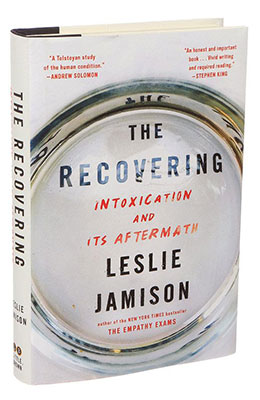 VERDICT: It’s a Keeper
VERDICT: It’s a Keeper
The Recovering: Intoxication and Its Aftermath
By Leslie Jamison (New York, NY: Hatchette Book Group, 2018). 534 pgs. $12.69. Order, www.amazon.com.
Reviewed by Nancy Barasch
Individuals’ struggle with alcoholism is a frequent artistic topic. Leslie Jamison is concerned that she is retelling a story, but she is a professional writer and her writing is excellent.
Her story begins with earning an M.F.A. in creative writing from the University of Iowa’s Writers’ Workshop and returning to Iowa City to teach. At every point in her life, she struggles with a daily obsession with alcohol. She writes about her attendance at AA meetings and her relapses.
Jamison thinks “platitude” when she hears people say “one day at a time,” until, as she puts it, “one day it wasn’t.” She analyzes the plot of AA members’ stories but knows that the desire to drink is never far from her mind.
Interspersed with her story is the colorful story of famous writers who have had substance abuse problems. Some, such as John Berryman, committed suicide after being unable to come to grips with their addiction. A few recovered and did their best writing while sober. Jamison views addiction as a stumbling block that is not helpful to writing, but this isn’t a simple conclusion.
In addition, Jamison makes a researched argument that the difference between an addiction being viewed as an illness or as a crime is race and that an appeal to racism is the origin of the escalating incarceration of users.
Billie Holiday was black. She died in a hospital bed shackled and handcuffed. On the day Jamison was welcomed at her first AA meeting another addicted woman in Arizona was placed in a steel cage and died from exposure to heat (the temperature was 104 degrees).
Readers who enjoy literary analysis and a description of writers’ lives will like this book.
Those who must consider what we should do with our broken criminal justice system might find this book essential.
Nancy Barasch, John Marshall 1985, resides in Kenosha.
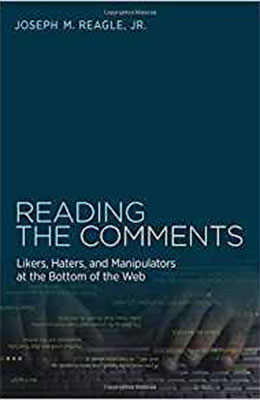 VERDICT: Touchdown!
VERDICT: Touchdown!
Reading the Comments: Likers, Haters, and Manipulators at the Bottom of the Web
By Joseph M. Reagle Jr. (Cambridge, MA: The MIT Press, 2015). 272 pgs. $27.95. Order, mitpress-orders@mit.edu.
Reviewed by Suzanne Edwards
As a television, computer, and audiobook fanatic, I rarely read a real paperbound book anymore. But I read most of Reading the Comments: Likers, Haters, and Manipulators at the Bottom of the Web during a satellite internet outage at my rural Iowa County house, and I am very glad I did.
This book is only 272 pages, but it is filled with history, humor, and perspectives on what today’s user comments tell us about human nature and culture. Reagle’s writing style is easygoing yet thought provoking. Beginning with the earliest forms of criticism and review found in the mid-1700s, Reagle quickly moves into the present-day forms found on the internet.
Reagle teaches us about what is found in “the bottom half of the internet,” meaning, the comments below articles, social media posts, products for sale, and other types of web content. His exploration of modern digital criticism via comments, likes, and emojis is divided into chapters titled, “Informed,” “Manipulated,” “Improved,” “Alienated,” “Shaped,” and “Bemused.” Each chapter illustrates how what we read online shapes what we like, what we buy, and how we feel about ourselves and each other. Reagle also writes about the profusion of internet fakers and scammers and how they operate.
I recommend this book to anyone who uses the internet, which today is everyone.
Suzanne Edwards, Chicago-Kent 1998, is a solo practitioner in Dodgeville and proud member of the Wisconsin Association of Criminal Defense Lawyers. Her interest in computers began with her first PC in 1986. She strives to stay current with computer technology, internet, and social trends.
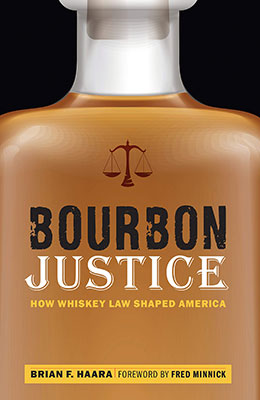 VERDICT: Touchdown!
VERDICT: Touchdown!
Bourbon Justice: How Whiskey Law Shaped America
By Brian F. Haara (Lincoln, Neb.: Potomac Books, 2018). 192 pages. $26.95. Order, www.amazon.com.
Reviewed by Chris Liro
The bourbon business is built on legend and lore. What better way to unearth the facts than court and legal records? Louisville, Ky., attorney Brian Haara, who writes about legal history and bourbon at his Sipp’n Corn blog, uses these sources to explore the colorful history of the bourbon industry and the effect of the business, its legal disputes, and its regulation on U.S. law. Haara presented his early research as a speaker at the 2016 Door County Intellectual Property Academy and now has published Bourbon Justice: How Whiskey Law Shaped America.
Haara’s meticulously researched book cites cases and legislation back to the 1800s to show how the bourbon business reflected the transition to a consumer economy based on large producers and national brands and away from a localized economy and laissez faire regulation. The book focuses on bourbon’s role in the development of trademark and brand name rights, advertising and labeling law, federal consumer protection, and even criminal procedure. He shows how the history relates to contemporary cases in the bourbon and other industries. And if the reader wants a break along the way, Haara provides his tasting notes on current bourbons related to the brands or the now-famous individuals appearing in this history.
Haara draws on many examples and stories to provide a narrative both educational and entertaining. Highlights include the Bottled-in-Bond Act of 1897 (the first instance of federal consumer protection legislation); the 1936 case of Churchill Downs Distilling Co v. Churchill Downs Inc., which established rights to protect trademarks against use by others in different industries; and more recent litigation involving the Maker’s Mark red-dripping-wax seal.
The book is enjoyable and entertaining, yet with enough citations and detail to find a place on the syllabus of a trademark or advertising law class. If you are a fan of legal history (or a fan of bourbon), I recommend this book.
Chris Liro, Michigan 2000, practices at Andrus Intellectual Property Law, Milwaukee, and is past chair of the State Bar of Wisconsin Intellectual Property and Technology Law Section.
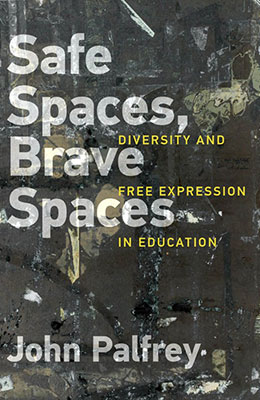 VERDICT: Not For Me, Maybe For You
VERDICT: Not For Me, Maybe For You
Safe Spaces, Brave Spaces: Diversity and Free Expression in Education
By John Palfrey (Cambridge, MA: MIT Press, 2017). 192 pgs. $19.95. Order, http://mitpress.mit.edu.
Reviewed by Thomas J. McClure
This is a book written for university faculty by one of their own. The author, John Palfrey, is a former professor and vice dean at Harvard Law School and currently is the head of school at Phillips Academy, Andover, Mass. Palfrey coauthored Born Digital: Understanding the First Generation of Digital Natives (2008). He has a keen eye for divisive cultural and political events that have riled society of late – and their effects on campus communities. The book is his answer about what higher education decision makers should do in response.
The author cites the primary drivers of recent campus controversies as being concerns over racial injustice and social and general inequality. The book is a thoughtful and nuanced call to action to address such concerns. Palfrey implores universities to take seriously the dissatisfaction of campus members who are minorities, or who are, or identify as, marginalized individuals; and to take serious steps to address their unrest through engagement and constructive actions.
Palfrey references how several social justice movements and campus incidents in 2014, 2015, and 2016 were highlighted by national media, and further publicized by proliferating social media, to create the current pressing problem. Various racial and inequity outrages spawned direct action by diverse groups to try to force universities to make radical institutional changes. These changes ranged from demanding more minority faculty and ridding the campuses of racist symbols to barring individuals from speaking on campuses. The 2016 presidential election further exacerbated concerns that free speech, with little empathy, was rank intolerance – and a harm that justified complete censorship. Some people argued that any support for the current president, or groups he appeared to support, should be purged from campuses.
Palfrey recognizes a balance must be struck – so that universities can fulfill their important core values of respectful free expression, as well as meaningful social justice, among all students. He calls for academics to act decisively to carefully decide protest issues, rethink campus behavior policies, and create speech and assembly mechanisms to address students’ needs for safety, respect, and constructive First Amendment expression. As Palfrey puts it, “we learn when we are presented with viewpoints different from our own,” assuming a respectful and equitable environment.
The actual title terms, “safe spaces” and “brave spaces,” are somewhat ethereal. “Safe spaces” refers to the concept of unique locations on campus where members of certain groups can be insulated from risk, insult, or conflict and be free to relax and express themselves (in a private, nonclassroom setting). “Brave spaces” is the term used to describe forums on campus where all students agree differing views may be publicly presented – in a sincere, respectful, and empathetic manner – “to confront the uncomfortable and unfamiliar and respond in ways to make them grow.”
Palfrey also allows that private universities, and religiously affiliated ones, may craft their policies differently than public institutions, to best serve their particular educational community.
Palfrey first reviews the social justice and political events that compelled him to write the book in his Introduction (chapter 1). Next, in chapter 2, Palfrey defines current “flashpoint” issues (typified by safe-space concerns, trigger warnings, micro aggressions, and calls to disinvite speakers on campus or change school heritage symbols or naming decisions on campus property). Chapter 3 makes the case for diversity. Chapter 4 covers the hard problem of hate speech. Chapter 5 makes the case for free expression. Chapter 6 discusses the enduring importance of free press and freedom of assembly. Chapter 7 concludes the book with Palfrey’s synthesis on why diversity and free speech matter.
In evaluating the book for an audience, I have reservations. First, it is more “academic” and theoretical, than practical, in its analysis. Second, unless the reader is steeped in and embraces the current lexicon of “political correctness” and empathy initiatives advocated (in contrast to the reality of legitimate countervailing views in our national conversation), the book is a hard slog. Finally, for lawyers, although the book could be helpful for getting updated on “cultural sensitivity,” it appears to be of limited professional value, unless the attorney’s practice involves discrimination or education law.
Thomas J. McClure, Marquette 1980, is a solo practice civil and criminal trial attorney in Delafield.
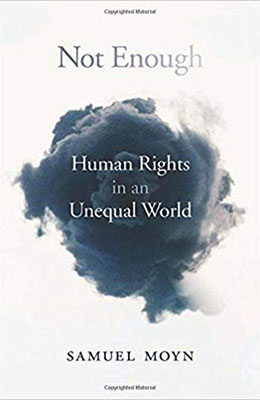 VERDICT: It’s a Keeper
VERDICT: It’s a Keeper
Not Enough: Human Rights in an Unequal World
By Samuel Moyn (Cambridge, MA: Harvard University Press, 2018). 296 pgs. $29.95. Order, www.hup.harvard.edu.
Reviewed by Lawrence G. Albrecht
Human rights law is under intellectual stress on many fronts for being imperfect in design, limited, ineffective, and unwilling to confront the emergent neoliberal political and economic order that has exacerbated global economic inequality and even because it threatens state sovereignty and global stability. Samuel Moyn joins the fray, but his mission, despite the mostly dismal history of human rights law that he surveys, is actually constructive: to restore and expand human rights’ focus on economic inequality and social rights.
Exercising his historian skills, Moyn details intertwined global developments in human rights law and economic theory. He particularly emphasizes the Western origins of egalitarianism, which have become subservient to neoliberal market faith that offers only economic “sufficiency” legal structures to address poverty while abandoning any economic equality agenda. Moyn brilliantly critiques a great paradox: particularly since the 1970s, global economic inequality has exploded simultaneously with the rise of human rights law. Why has this stark disconnect resulted, and what should be the reordered mission of human rights law, given its prior ineffectual efforts at redressing economic and social inequality?
Moyn’s historical critique of human rights law is both devastating and provocative. However, his critique is narrowly cabined in the deep hull of economic injustice and does not explore the significant advances human rights law has made in the fields of political rights, minority and gender equality, and environmental protection.
With respect to Moyn’s primary focus on economic inequality “in the neoliberalism maelstrom,” he does briefly address French economist Thomas Piketty’s recent groundbreaking work in analyzing the structural causes of inequality in “Croesus’s world,” as Moyn strikingly characterizes the contemporary global scenario, which also includes the reactive rise of populist political movements.
Moyn has diagnosed the historical malaise of economic inequality and social repression. But it remains for domestic governments and the international community to fill the curative prescriptions. Human rights organizations and advocates must continue to serve as spokes in the wheels of governmental failures and injustice and contextually prioritize their respective missions.
Lawrence G. Albrecht, Valparaiso 1973, is the president of First, Albrecht & Blondis s.c, Milwaukee.
